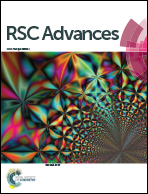Time-efficient syntheses of nitrogen and sulfur co-doped graphene quantum dots with tunable luminescence and their sensing applications†
Abstract
Heteroatom doped graphene quantum dots (GQDs) are particularly promising in bioimaging and fluorescent sensing because of their better photoluminescence tunability compared to pristine GQDs. Herein, two nitrogen and sulfur co-doped GQDs (N,S-GQDs) with varied fluorescence emission wavelength were synthesized via HNO3 vapour cutting route, in which a porous polythiophene-derived carbon served as the sulfur source while the HNO3 vapour was presented as the scissor and the nitrogen source. The as-prepared N,S-GQDs exhibited blue and yellow-green coloured fluorescence, owing to their varied morphologies and surface states resulted from varied reaction temperature. Compared to the typical top-down syntheses via hydrothermal or solvothermal routes, the present HNO3 vapour cutting method is prominently efficient in time expense and product separation. An application of the obtained greenish-yellow N,S-GQDs for highly selective and sensitive fluorescent detection of Fe3+ was demonstrated, with a linear range of 0–130 μM and a detection limit of 0.07 μM. The protocol reported here can also be readily applied for facial synthesis of other heteroatom doped GQDs.


 Please wait while we load your content...
Please wait while we load your content...